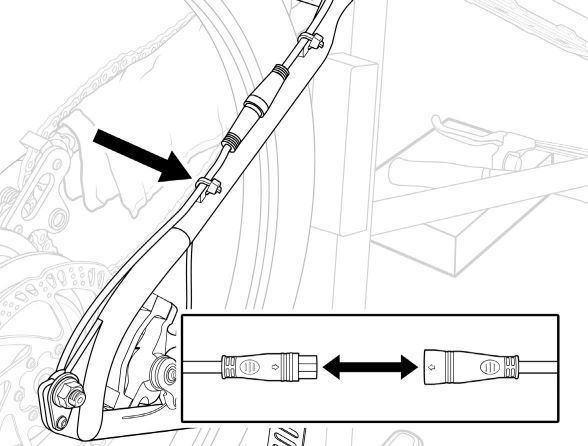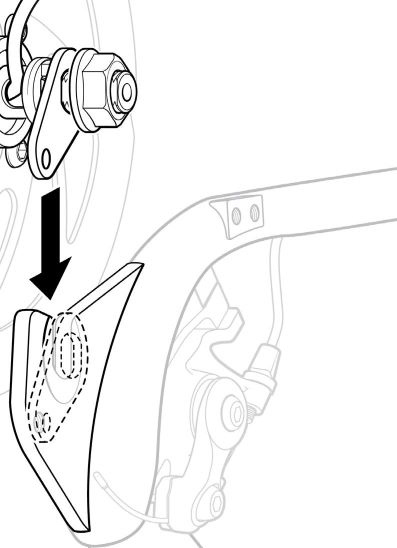RadMission full fenders installation guide
The RadMission full fenders have been designed to offer riders full-coverage protection from snow, water, and sand while riding. Use the procedure below to install full fenders on a RadMission.
RadMission fender kits include:
| Contents | # | Size |
| Front and rear fender | 1 | — |
| Fork crown mounting bolt | 1 | M6 x 60 mm |
| Flat washers (2 for fork crown, 1 for chainstay brace, 1 for seatstay brace) | 4 | — |
| Locknut | 1 | M6 |
|
Bolts with captive lock washer and flat washer for:
|
4 1 1 |
M5 x 12 mm M5 x 18 mm M5 x 14 mm |
| Zip ties | 3 | — |
Tools needed:
- 4 mm Allen wrench
- 5 mm Allen wrench
- 10 mm wrench
- 18 mm wrench
- Flat side cutters
- Clean shop or paper towel
- Torque wrench (capable of torquing between 6 Nm - 40 Nm)
- Wood blocks (to protect the display when the bike is flipped over)
Hardware may vary (bolt head style) and/or require different tools. Use the appropriate head size and type of tool for your bolts. Ensure the tool is pressed firmly into the bolt head and turn slowly to prevent stripping.
Install the front fender
- Get the bike ready for installation. Turn off the bike, remove the battery, and press and hold the power button to discharge remaining power.
- Put the bike in a stand or have a friend stabilize it.
- Locate and remove the front fender mounting hardware.
- At the front fork crown, use a 5 mm Allen wrench and a 10 mm wrench to remove the hardware.
- Recycle the hardware according to local rules. You will use the fender kit hardware to install the fenders.
- Locate and prepare the front fender mounting hardware.
- Locate the front fork mounting bolt (M6 x 60 mm), two flat washers, and the lock nut.
- Pass a bolt through a flat washer. Set the hardware, including the second washer and lock nut, near the fender.
- Pass the front fender into position from the back of the front wheel until the fender metal mounting tab is against the mounting point at the rear of the fork crown.

- Secure the fender to the fork crown.
- Pass the bolt through a flat washer, the front of the fork crown mounting point, and the fender mounting tab. Pass a flat washer over the bolt end and thread the lock nut onto the bolt end.
- Use a 5 mm Allen wrench and a 10 mm wrench to tighten the hardware partway.

- Locate and install the front fender mounting arm bolts.
- Locate two fender mounting arm bolts.
- On one side of the bike, place the fender mounting arm eyelet on the mounting hole on the fork dropout.

- Pass the bolt through the fender mounting arm eyelet and into fork dropout by hand.
- Use a 4 mm Allen wrench to tighten partway.
- Repeat on the other side.

- Ensure the fender is centered and has clearance around the wheel. Adjust by hand if needed.
- Tighten the fork crown mounting bolt and the two fender mounting arm bolts securely. Torque all three bolts to 6 Nm.
Install the rear fender
- Carefully flip the bike over and prop the handlebar grips on blocks to protect the display.

- Unplug the motor cable. Snip the zip tie at the motor cable. Pull the connector directly apart to unplug.

- Remove the rear wheel:
- Remove the chain from front chainring: Place a paper towel over the chainstay to protect the chainstay paint. Rotate the right crank counterclockwise until the pedal is forward. Grab the chain with a second paper towel, pull the chain away from the bike, then rotate the crank counterclockwise to remove the chain. Use caution to avoid getting pinched between the chainring and the chain. If needed, add slack by pushing the chain tensioner forward.

- Remove the torque arm bolt and loosen (but don't remove) the motor axle bolts. Use a 4 mm Allen wrench to remove the torque arm bolt. Use an 18 mm wrench to loosen the motor axle bolts on both sides of the wheel.

- Remove the wheel. Lift the wheel up and out of dropouts, remove the chain from the rear cog, and set the wheel aside.
- Remove the chain from front chainring: Place a paper towel over the chainstay to protect the chainstay paint. Rotate the right crank counterclockwise until the pedal is forward. Grab the chain with a second paper towel, pull the chain away from the bike, then rotate the crank counterclockwise to remove the chain. Use caution to avoid getting pinched between the chainring and the chain. If needed, add slack by pushing the chain tensioner forward.
- Attach the rear fender to the chainstay and seatstay.
- Locate two M5 x 12 mm bolts and two flat washers.
- Place the fender in position with the flat side near the chainstay.
- Thread the bolts into the chainstay brace and seatstay brace by hand and use a 4 mm Allen wrench to tighten partway.
- Tighten both bolts securely and torque to 6 Nm.

- Reinstall the rear wheel.
- Align the brake rotor with the caliper so the brake rotor will easily enter the caliper. Do not pinch the motor cable or touch the brake rotor.
- Reinstall the chain on the rear cog, then align the chain and rotate the crank counterclockwise to install the chain on the front chainring.
- Align the axle in the dropouts with the torque arm on the outside of the frame.
- Lower the wheel and ensure the axle is fully seated in both dropouts.

- Locate the new torque arm/fender mounting bolt.
- Place the left-side fender mounting arm eyelet over the torque arm mounting point. Install the bolt through the eyelet, torque arm mounting point, and thread into the frame carefully by hand. Use a 4 mm Allen wrench to tighten partway.

- Use an 18 mm wrench to tighten the motor axle nuts evenly. Alternate between bolts while tightening to ensure the axle remains level and fully seated in the dropouts. Tighten the bolts securely. Torque to 40 Nm.
An improperly secured front or rear wheel can cause loss of control, accidents, serious injury, or death. Check that both wheels are properly secured during assembly, reassembly, and before each ride.
- Plug in the motor cable. Line up the internal and external markings and press together, without twisting, to connect. Use zip ties to secure the cable away from moving parts. Snip zip tie excess until flush and smooth.

- Attach the other fender mounting arm to frame.
- Place the right-side fender mounting arm eyelet over the mounting point. Install the bolt through the eyelet and thread into the frame carefully by hand.

- Ensure the fender is centered and has clearance around the wheel.
- Use a 4 mm Allen wrench to tighten the bolt securely.
- Torque both fender mounting arm bolts to 6 Nm.
- Place the right-side fender mounting arm eyelet over the mounting point. Install the bolt through the eyelet and thread into the frame carefully by hand.
- Stand the bike upright, reinstall the battery, and test the bike fully before riding. Ride Rad!
